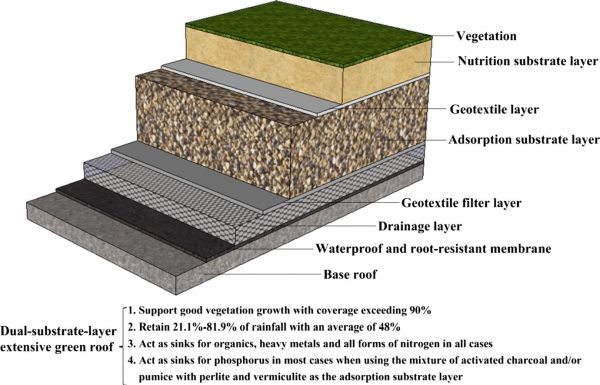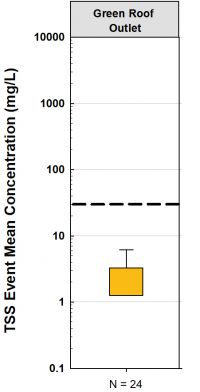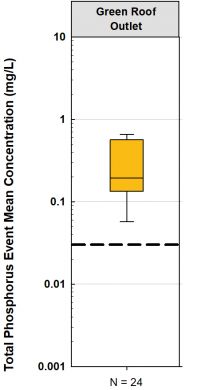Green Roof: Performance
TSS Reduction[edit]
The performance results for Rainwater harvesting practices, located within TRCA's watershed originate from two sites:
- Archetype Sustainable House A green roof (Kortright Centre, Vaughan)
- York University (North York)
The mean performance value recorded at each of the green roof facilities, was to measure their ability to remove Total Suspended Sediments (TSS), which was calculated based on 24 separate recordings from 2003-2004, and 2008 at both of the aforementioned locations listed above.
As can be seen in the corresponding boxplot the mean performance removal efficiency of the rainwater cistern practices monitored are well below the suggested guideline of 30 mg/L (Canadian Water Quality Guideline (CWQG), or (background (assumed at <5 mg/L)+ 25 mg/L for short term (<24 hour) exposure) (CCME, 2002[1]; (TRCA, 2021[2]).
The median value of the 24 samples taken was 1.25 mg/L whereas the mean was 2.80 mg/L, with a 0% guideline exceedance.
Phosphorus Reduction[edit]
The performance results for Rainwater harvesting practices, located within TRCA's watershed originate from two sites:
- Kortright Green Roof (Vaughan)
- York University (North York)
The mean performance value recorded at each of the green roof facilities, was to measure their ability to remove Total Phosphorus (TP), which was calculated based on 24 separate recordings from 2003-2004, and 2008 at both of the aforementioned locations listed above.
As can be seen in the corresponding boxplot, the mean performance removal efficiency of the green roof practices monitored is not meeting the acceptable upper extent range of nutrients as it is 0.03 mg/L (30 µg/L) (Environment Canada, 2004[3]; OMOEE, 1994[4]).
The median value of the 24 samples taken was 0.19 mg/L whereas the mean was 0.30 mg/L, with a 100% guideline exceedance. Given the small sample size of just 24 grab samples further monitoring projects will be required to ensure that the results collected are as accurate as possible to ensure these practices can meet federal and provincial governments' guideline requirements for TP stormwater quality. These results were the highest of all practices monitored.
Please refer to the Phosphorus page and the additives page for more information on how LIDs can reduce contaminant loading in stormwater
Recent Performance Research[edit]
- (Reddy et al. 2014) - Evaluation of Biochar as a Potential Filter Media for the Removal of Mixed Contaminants from Urban Storm Water Runoff
- This research study conducted by the University of Illinois found that biochar (as a potential filter media for substrate/filter media in vegetative green roofs) effectively reduced TSS of the runoff by approximately 86% (influent/effluent = 148 mg/L / 20.75 mg/L) and the phosphate concentration by 47% (influent/effluent = 0.57 mg/L / ~0.30 mg/L) . In addition, the concentrations of other heavy metals were reduced between 17–75% (Reddy et al. 2014[5]).

- (Malcom, et al. 2014) - Measurements of nutrients and mercury in green roof and gravel roof runoff
- This study compared the runoff and nutrient load reduction performance of sample green roof and gravel plots and two sets of real gravel and green roofs, located in Norfolk, VA. The green roofs and green roof plots outperformed the gravel roof treatments and gravel roof plots in stormwater runoff volume. Meanwhile, concentrations of total phosphorus in runoff from the green treatments were consistently much higher (1.0 – 3.2 mg/L) than that from gravel roofs (less than 0.2 mg/L), even after accounting for rain amount. For half of the storms with a calculated P load, 10 to 180 times more phosphorus leached from the green roof plots in comparison to the gravel ones. Although this is true, the researchers found that the reduction in runoff volume (99.8%) was enough to compensate for the higher concentration of P from the green roofs and resulted in an overall lower total load. This suggests that fertilized green roofs can be a source of phosphorus, and as a result caution is recommended when considering the application of fertilizer during installation/maintenance of green roof practices, especially in the first few years, even though it can improve and expediate plant growth (Malcom, et al. 2014[7].
- (Wang, et al. 2017) - The influence of dual-substrate-layer extensive green roofs on rainwater runoff quantity and quality
- This study looked at the performance ability of dual-substrate-layer (DSL) "extensive green roofs" to both retain stormwater and reduce pollutant load leaching and compared it to that of a traditional (SSL) single-substrate-layer green roof practice. The DSL green roofs supported better natural vegetation growth, (+90% coverage compared to ~80% coverage for SSL), and possessed better average retention values of the total rainfall for four types of simulated rain events. Meanwhile, all of the DSL green roofs appeared to be sinks for organics, heavy metals and all forms of nitrogen but acted as sources of phosphorus loading during heavy simulated rain events. Future consideration was given to adding a mixture of activated charcoal and/or pumice with perlite and vermiculite as an adsorption substrate to help improve TP leaching control in DSLs (Wang, et al. 2017[8]).
References[edit]
- ↑ Canadian Council of Ministers of the Environment (CCME). 2002. Canadian water quality guidelines for the protection of aquatic life: Total particulate matter. In: Canadian Environmental Quality Guidelines, Canadian Council of Ministers of the Environment, Winnipeg
- ↑ TRCA. 2021. Spatial Patterns (2016-2020) and Temporal Trends (1966-2020) in Stream Water Quality across TRCA’s Jurisdiction Prepared by Watershed Planning and Ecosystem Science. https://trcaca.s3.ca-central-1.amazonaws.com/app/uploads/2021/10/29113334/2016-2020-SWQ-Report-v11_FINAL_AODA-FA.pdf
- ↑ Environment Canada. (2004). Canadian guidance framework for the management of phosphorus in freshwater systems. Ecosystem Health: Science‐based solutions report no. 1–8. Cat. No. En1–34/8–2004E.
- ↑ Ontario Ministry of Environment and Energy (OMOEE), 1994. Policies, Guidelines and Provincial Water Quality Objectives of the Ministry of Environment and Energy. Queen’s Printer for Ontario. Toronto, ON.
- ↑ Reddy, K.R., Xie, T. and Dastgheibi, S. 2014. Evaluation of biochar as a potential filter media for the removal of mixed contaminants from urban storm water runoff. Journal of Environmental Engineering, 140(12), p.04014043.
- ↑ Wang, X., Tian, Y. and Zhao, X. 2017. The influence of dual-substrate-layer extensive green roofs on rainwater runoff quantity and quality. Science of the total environment, 592, pp.465-476.
- ↑ Malcolm, E.G., Reese, M.L., Schaus, M.H., Ozmon, I.M. and Tran, L.M. 2014. Measurements of nutrients and mercury in green roof and gravel roof runoff. Ecological Engineering, 73, pp.705-712.)
- ↑ Wang, X., Tian, Y. and Zhao, X. 2017. The influence of dual-substrate-layer extensive green roofs on rainwater runoff quantity and quality. Science of the total environment, 592, pp.465-476.

